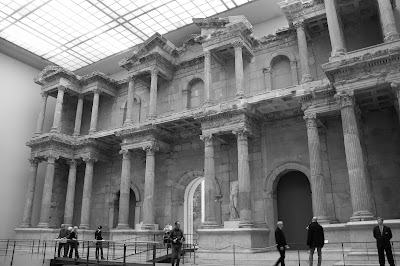The Pergamon Museum contains much more than we had time to see. There were however a few items which stood out, in addition to the great Ishtar Gate mentioned in the previous post. These first two images are of the reconstructed Market Gate of Miletus, a Roman construction from around AD100. The Pergamon museum many decades ago took the controversial decision to use the archaeological finds as a basis for complete reconstruction of the buildings with signifiacnt additions of new material. So what the visitor sees here is something which is marketed as a 'live album' but which largely consists of studio overdubs... (or something). This gate adorned the great city of Miletus, but was not completed until approximately forty years after 'St' Paul's several visits to the city described in the New Testament book of The Acts of the Apostles.
The photos above and below are the remaining fragments of huge statues of Hadrian and Trajan respectively. Roman political-theology welded together the adoration and ritual honouring of their gods with the veneration of Emperors who were given a semi-divine status. Participation in worship of these statues of the Emperors therefore become as much a matter of loyalty to the Roman State as it was something done borne out of theological conviction or spirituality. The museum provides headsets with brilliant commentary on all the exhibits, available in many languages, it was this commentary that said something interesting about this statue of Trajan. It said that while participation in the state religious rituals was near universal, the one group who refused to take part was the early Christian community for whom idol worship was fundamentally incompatible with their beliefs. It was their refusal to worship this piece of stone, which led to the persecution of the Christian church by the Roman Empire throughout the Middle East.
Empires come and go, but history lives on. This week both Labour, Shadow Foreign Secretary, MP Douglas Alexander and Prince Charles have brought attention to the plight of Christians in the Middle East today. The threat today looks substantially different to the enforced Emperor worship of Trajan's Roman empire; but yet is strikingly similar. Islamism is a religio-political movement which seeks to use religion as a political tool, and which makes outward observance of its religious code a matter of loyalty to its vision of the state. Like in Rome, what is perceived as 'heresy' is defined as 'treason' and therefore subject to the most severe persecution. Many good organisations campaign for religious freedom in the Middle East today, click here to find out more.
Moving from room to room through the Pergamon Museum involved leaping through the centuries in the imagination. In Biblical terms, turning a corner is like flipping over from the Acts of the Apostles to the early books of Old Testament History. These final three photos take us into the book of 2 Kings, 2 Chronicles and Isaiah. Prior to the hegemony of Babylon, Assyria was the major regional power in the Ancient Near East. After Israel was divided into two kingdoms by Solomon's sons, Assyria assaulted The Northern Kingdom and conquered it. Sennacherib's assault on Jerusalem during the reign of King Hezekiah is on of the great escape stories of the Old Testament. 2 Kings 18-19 describes the siege of Jerusalem, and Hezekiah's pleading with God for deliverance, in the temple. In response the angel of the Lord attacked the Assyrian troops at night, and Sennacherib return to Nineveh, where he was subsequently killed by his own sons pursuing his throne.
This water tank from archaeological digs of ancient Assyria, features inscriptions and depictions of the great King Sennacherib.
These battle-reliefs, feature images of the greatly feared and well-armed Assyrian troops.
Like Babylon, Assyria was a nation whose religious life was strongly orientated around idol worship. This Assyrian statue represented a weather-god, veneration of whom was supposed to secure the ideal conditions for the fruitful harvest upon which the whole society depended. The arms have long fallen off the statue but contained a spear in one hand and a lightning bolt in the other. The Old Testament presents such idols as these as a source of constant temptation for the Jewish people. While they very rarely actually abandoned the worship of YHWH as directed in the Law of Moses, the complaint of the prophets like Elijah, was that they combined it with the worship of idols like this one. The Baal's were thought to be fertility gods who could supply harvests and so forth, if suitably venerated and appeased. The temptation for the people was to 'hedge their bets' between God and the Baals, seeking to keep both on side. Old Testament theology revolves around the central idea that YHWH is the one true God, who will not share His people with rivals; but who called His people to trust Him for everything.









No comments:
Post a Comment